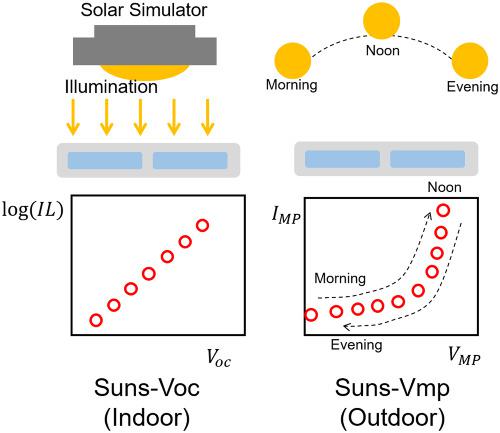当前位置:
X-MOL 学术
›
Prog. Photovoltaics
›
论文详情
Our official English website, www.x-mol.net, welcomes your
feedback! (Note: you will need to create a separate account there.)
Real‐time monitoring and diagnosis of photovoltaic system degradation only using maximum power point—the Suns‐Vmp method
Progress in Photovoltaics ( IF 8.0 ) Pub Date : 2018-07-26 , DOI: 10.1002/pip.3043 Xingshu Sun 1 , Raghu Vamsi Krishna Chavali 1 , Muhammad Ashraful Alam 1
Progress in Photovoltaics ( IF 8.0 ) Pub Date : 2018-07-26 , DOI: 10.1002/pip.3043 Xingshu Sun 1 , Raghu Vamsi Krishna Chavali 1 , Muhammad Ashraful Alam 1
Affiliation

|
The uncertainties associated with technology‐specific and geography‐specific degradation rates make it difficult to calculate the levelized cost of energy, and thus the economic viability of solar energy. In this regard, millions of fielded photovoltaic modules may serve as a global testbed, where we can interpret the routinely collected time series maximum power point (MPP) data to assess the time‐dependent “health” of solar modules. The existing characterization methods, however, cannot effectively mine/decode these datasets to identify various degradation pathways. In this paper, we propose a new methodology called the Suns‐Vmp method, which offers a simple yet powerful approach to monitoring and diagnosing time‐dependent degradation of solar modules by using the MPP data. The algorithm reconstructs “IV” curves by using the natural illumination‐dependent and temperature‐dependent daily MPP characteristics as constraints to fit physics‐based circuit models. These synthetic IV characteristics are then used to determine the time‐dependent evolution of circuit parameters (eg, series resistance), which in turn allows one to deduce the dominant degradation modes (eg, solder bond failure) of solar modules. The proposed method has been applied to a test facility at the National Renewable Energy Laboratory. Our analysis indicates that the solar modules degraded at a rate of ~0.7%/year because of discoloration and weakened solder bonds. These conclusions are validated by independent outdoor IV measurements and on‐site imaging characterization. Integrated with physics‐based degradation models or machine learning algorithms, the method can also serve to predict the lifetime of photovoltaic systems.
中文翻译:

仅使用最大功率点(Suns-Vmp方法)实时监视和诊断光伏系统退化
与特定技术和特定地理位置的退化率相关的不确定性使得难以计算平准化的能源成本,从而难以计算太阳能的经济可行性。在这方面,数百万个已部署的光伏模块可以用作全球测试平台,在这里我们可以解释常规收集的时间序列最大功率点(MPP)数据,以评估太阳能模块随时间变化的“健康状况”。但是,现有的表征方法无法有效地挖掘/解码这些数据集以识别各种降解途径。在本文中,我们提出了一种称为Suns-Vmp方法的新方法,它提供了一种简单而强大的方法,即通过使用MPP数据来监视和诊断太阳能模块随时间变化的退化。该算法通过使用自然照度和温度相关的每日MPP特性作为约束条件来拟合基于物理电路模型,从而重建“ IV”曲线。然后,这些合成的IV特性用于确定电路参数(例如,串联电阻)随时间的变化,从而可以推断出太阳能模块的主要降级模式(例如,焊料键合失效)。提议的方法已应用于国家可再生能源实验室的测试设施。我们的分析表明,由于变色和弱化的焊料键合,太阳能电池组件的降解率约为每年0.7%。这些结论通过独立的室外IV测量和现场成像表征得到了验证。与基于物理的退化模型或机器学习算法集成后,该方法还可用于预测光伏系统的寿命。
更新日期:2018-07-26
中文翻译:

仅使用最大功率点(Suns-Vmp方法)实时监视和诊断光伏系统退化
与特定技术和特定地理位置的退化率相关的不确定性使得难以计算平准化的能源成本,从而难以计算太阳能的经济可行性。在这方面,数百万个已部署的光伏模块可以用作全球测试平台,在这里我们可以解释常规收集的时间序列最大功率点(MPP)数据,以评估太阳能模块随时间变化的“健康状况”。但是,现有的表征方法无法有效地挖掘/解码这些数据集以识别各种降解途径。在本文中,我们提出了一种称为Suns-Vmp方法的新方法,它提供了一种简单而强大的方法,即通过使用MPP数据来监视和诊断太阳能模块随时间变化的退化。该算法通过使用自然照度和温度相关的每日MPP特性作为约束条件来拟合基于物理电路模型,从而重建“ IV”曲线。然后,这些合成的IV特性用于确定电路参数(例如,串联电阻)随时间的变化,从而可以推断出太阳能模块的主要降级模式(例如,焊料键合失效)。提议的方法已应用于国家可再生能源实验室的测试设施。我们的分析表明,由于变色和弱化的焊料键合,太阳能电池组件的降解率约为每年0.7%。这些结论通过独立的室外IV测量和现场成像表征得到了验证。与基于物理的退化模型或机器学习算法集成后,该方法还可用于预测光伏系统的寿命。











































 京公网安备 11010802027423号
京公网安备 11010802027423号